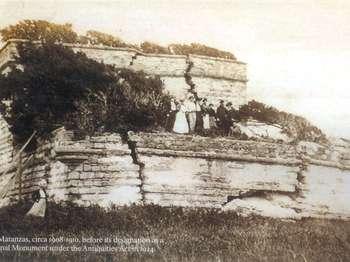Last updated: April 14, 2021
Place
Preservation

Historical/Interpretive Information/Exhibits
When Florida was ceded to the United States in 1821 the tower was abandoned and almost forgotten for nearly one hundred years. It was not until 1916 that efforts were first made to preserve this unique part of America's history. The National Park Service continues to preserve this structure for future generations.
1916
Early on, the United States War Department believed that the construction of modern coastal fortifications was a priority and was unprepared to devote any of its resources to preservation of obsolete fortifications. Finally things changed in 1916 when a Fortification Bill was signed and money was appropriated. These repairs stabilized the areas which needed the most attention and removed some vegetation from the fort. Funding ceased when the U.S. entered World War I.
1924
In early 1924 another authorization was made to conduct repairs on the fort. These repairs included tearing down and rebuilding portions of the East and South walls of the gun platform. Many stones were removed and much of the original stone was used in reconstructing these walls. Later that year, President Calvin Coolidge issued an order which declared Fort Matanzas a National Monument. Among the many projects undertaken at this time was a $750 allotment to reconstruct a sentry box.
1935
The National Park Service took over full operation of Fort Matanzas on July 1, 1935. At the height of the Great Depression the Public Works Administration (PWA), not to be confused with the Works Progress Administration (WPA) allotted funding specifically for restoration of the old watchtower. Projects included a complete reconstruction of the tower arch and a portion of the south side of the tower wall. Also, for the first time in the history of Fort Matanzas, a sea wall was installed around the building to prevent further erosion. Across the Matanzas River, land was set aside to build a visitor center complex. This visitor center still stands in operation today! Over the years, additional projects have been undertaken for the continued preservation and public use of the monument.
1972
The National Park Service began the current ferry service in 1972 when a local boat captain started a concession operation to take people to the fort. Over the years, the monument has also gone through a series of different boat docking facilities. The first was wood, followed by aluminum, and later upgraded to a floating concrete platform which now houses the park's ferry service. Today the monument has two Ferry Boats which carry over 70,000 visitors a year, while the overall park receives over 600,000. Today's funding for future projects actually comes from the admission fees taken at the Castillo de San Marcos National Monument. A percentage of those sales help keep the boats in service and fund future projects geared to preserving and maintaining this national treasure for the enjoyment of future generations.
